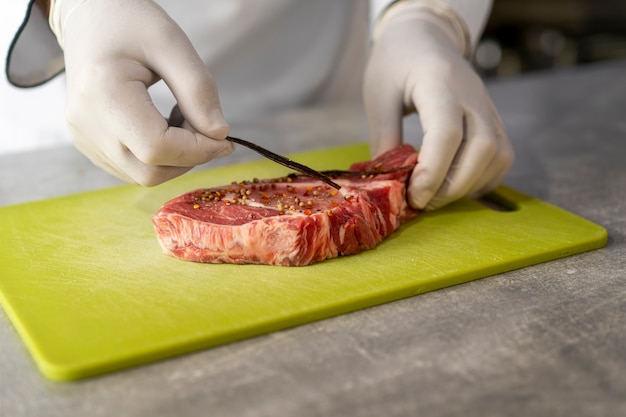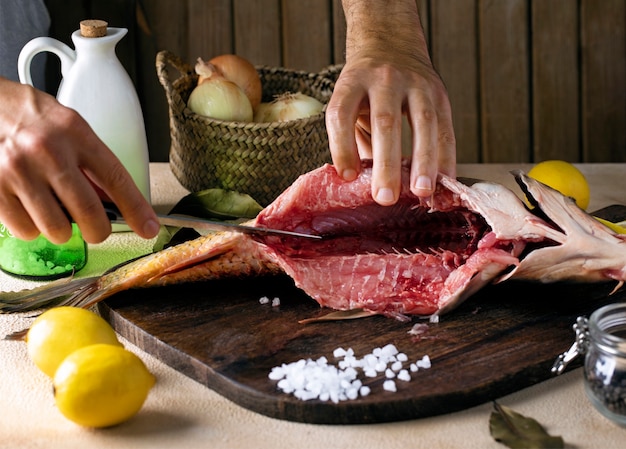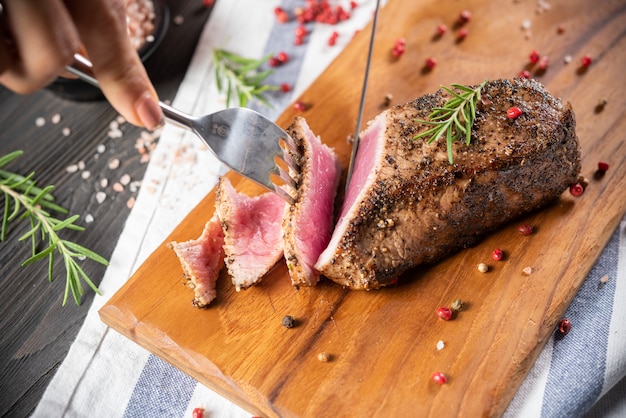Let’s talk about steak. You know, the kind that practically melts in your mouth, the kind that leaves you licking the plate clean, the kind that makes you dream about the next time you’ll get to enjoy it. It’s not about fancy restaurants or Michelin-starred chefs. It’s about getting your hands dirty in the kitchen, learning a few tricks, and crafting a truly delicious steak that everyone will rave about.
(Part 1) Choosing Your Weapon: The Perfect Cut

You can’t expect to conquer the world of steak without the right tool for the job. choosing the right cut is like selecting the perfect outfit for a night out – it needs to suit the occasion. You want a cut that complements your cooking method and, most importantly, satisfies your taste buds.
The Rib-Eye: The Classic Choice
Think of the rib-eye as the little black dress of the steak world: always elegant, always a good choice. Its generous marbling, those little streaks of fat throughout the meat, gives it a rich, buttery flavor that melts in your mouth. It’s perfect for those who crave both tenderness and depth of flavor.
The Sirloin: Lean and Mean
The sirloin is a leaner cut, meaning it has less marbling and a firmer texture. It’s like the cool, sophisticated friend who always makes a statement. It’s fantastic for grilling or pan-frying, offering a balance of flavor and tenderness, a bit more robust than the rib-eye.
The Fillet: The Ultimate Indulgence
Now, the fillet is the epitome of tender, luxurious indulgence. It’s the crème de la crème, the most expensive cut for a reason. It’s so tender it practically melts in your mouth, a true culinary masterpiece. If you’re looking for a steak that’s all about the sheer enjoyment of the experience, the fillet is your go-to.
The Rump Steak: The Workhorse
The rump steak is the tough-but-tender friend, the one who's always up for a challenge. It’s a more robust cut, requiring a bit more attention and care during cooking. However, it packs a punch of flavor, perfect for grilling or pan-frying, and it’s a great choice for those who appreciate a bit more chew.
(Part 2) Getting Ready for the Show: Prepping the Steak

You’ve got your cut, now it’s time to prep it for the big performance. It’s like getting ready for a night out, you want your steak looking its best.
Seasoning: The Secret Ingredient
First things first, pat the steak dry with paper towels. This helps remove any excess moisture that could prevent the steak from browning properly. Now, for the magic touch: seasoning! I prefer coarse sea salt and freshly ground black pepper, but feel free to experiment with what you like. The key is to enhance the steak's natural flavors, not drown them.
Adding a Touch of Finesse: Herbs and Spices
This is where you add your personal touch, a bit of flair that makes your steak truly yours. I love rubbing a little garlic powder and onion powder onto my steak before cooking, creating a subtle yet delicious depth of flavor. Others might prefer paprika, rosemary, thyme, or even a pinch of chili flakes for a bit of heat. Let your imagination run wild!
(Part 3) Cooking Your Steak: The Grand Finale

Alright, it’s showtime. This is where you bring your steak to life, where you showcase your culinary skills.
Pan-Frying: The Quick and Easy Option
Pan-frying is a great option if you're short on time. Heat some oil in a pan over high heat, then sear the steak for a couple of minutes per side. Aim for a beautiful crust on the outside while keeping the inside juicy and tender.
Grilling: The Classic Technique
Grilling offers a classic, smoky flavor that's hard to beat. Preheat your grill to high heat, then cook the steak for a couple of minutes per side, creating those coveted char marks. Be careful not to overcook it!
Oven Baking: For an Even Cook
For a more even cook, consider baking your steak in the oven. Preheat your oven to 400°F (200°C), then place the steak on a baking sheet. Bake for about 10 minutes per side, or until it reaches your desired level of doneness.
(Part 4) Knowing When it's Done: The Art of Doneness
So, how do you know when your steak is cooked to perfection? There are a few trusty methods to help you nail that perfect level of doneness.
The Finger Test: A Classic Method
Press your finger against your palm, right below your thumb. You’ll feel a fleshy spot, right? Now, press your finger against your steak. If it feels about the same firmness, it’s rare. If it feels a bit firmer, it’s medium-rare. If it feels quite firm, it’s medium. And if it feels really firm, it’s well-done.
Using a Thermometer: For Precision and Peace of Mind
If you're not feeling confident with the finger test, a meat thermometer is your best friend. It provides precise measurements for different levels of doneness:
| Doneness | internal temperature (°F) | Internal Temperature (°C) |
|---|---|---|
| Rare | 125-130 | 52-54 |
| Medium-Rare | 130-135 | 54-57 |
| Medium | 135-140 | 57-60 |
| Medium-Well | 140-145 | 60-63 |
| Well-Done | 145-150 | 63-66 |
(Part 5) Resting the Steak: A Moment of Patience
Once your steak is cooked, it's crucial to let it rest for a few minutes before slicing. This allows the juices to redistribute throughout the meat, resulting in a more tender and juicy steak. A minimum of 5 minutes is recommended, but 10 minutes is even better.
Resting Techniques
You can rest the steak on a cutting board covered with foil or transfer it to a plate and cover it with a clean tea towel. The key is to keep it covered to prevent it from drying out.
(Part 6) Slicing the Steak: A Gentle Touch
Now comes the art of slicing. Don't just hack at it with a knife, take your time and be careful. I prefer a sharp chef's knife, but use whatever you're comfortable with.
Slicing Techniques for Tenderness
Slice the steak against the grain, which means cutting across the muscle fibers. This will make the steak easier to chew and significantly more tender.
(Part 7) Serving the Steak: The Perfect Ensemble
Your steak is ready to be served, but don't forget the supporting cast! A steak is nothing without its companions.
side dish Options: Classic and Creative
You can't go wrong with classic sides like mashed potatoes, roasted vegetables, or a green salad. But feel free to get creative and explore different options. I love pairing my steak with sauteed mushrooms and onions or a simple side of grilled asparagus.
Sauce Suggestions: A Touch of Decadence
For a touch of decadence, add a sauce to your steak. Peppercorn sauce is a classic choice, but you can also explore red wine sauce, mushroom sauce, or blue cheese sauce.
(Part 8) Enjoying the Steak: The Moment of Truth
The moment of truth has arrived! It’s time to dig in and enjoy your perfectly cooked steak.
Savor the Experience
Take your time, savor each bite. You’ve worked hard to create this culinary masterpiece, so enjoy the fruits of your labor. Feel free to add a pinch of salt and pepper to taste, to your liking.
(Part 9) Tips and Tricks: Mastering the Art of steak cooking
Here are some tips and tricks I’ve learned over the years:
Using a cast iron skillet: The Ultimate Heat Retention
A cast iron skillet is a great tool for cooking steak. It retains heat exceptionally well, helping to create that beautiful crust on the outside.
Don't Crowd the Pan: Give Your Steak Room to Breathe
When you're pan-frying your steak, don't crowd the pan. This will lower the temperature of the oil and prevent the steak from browning properly.
Let the Steak Rest: Patience is a Virtue
As mentioned earlier, always let your steak rest for a few minutes before slicing. This helps keep it juicy and flavorful.
Don't Overcook the Steak: A Matter of Respect
It’s tempting to overcook a steak, but remember, overcooked steak is dry and tough. Cook it to your desired level of doneness and then leave it be.
(Part 10) FAQs: Answering Your Steak-Related Questions
Here are some of the most frequently asked questions about cooking steak:
Q: What's the best way to prevent a steak from sticking to the pan?
A: Heat the pan properly, then add a good amount of oil. The pan should be hot enough to sizzle when you add the steak. Let the steak cook for a few minutes on each side before you try to move it.
Q: What happens if I don't let the steak rest?
A: If you don't let the steak rest, the juices will run out when you slice it, and the steak will be dry and tough.
Q: What's the best way to reheat steak?
A: The best way to reheat steak is in the oven. Preheat your oven to 350°F (175°C), then place the steak on a baking sheet. Cook it for about 10 minutes, or until it's heated through.
Q: What if I overcook the steak?
A: Don't fret, it's not the end of the world! Overcooked steak is still edible, just not as tender and juicy as it could be. You can try slicing it thinly and serving it with a sauce to help disguise the dryness.
Q: Can I use different seasonings for my steak?
A: Absolutely! Experiment with different herbs and spices to find your perfect flavor combinations.
There you have it, folks. The ultimate guide to cooking a perfectly tender steak. Remember, it takes a bit of practice, but with a little patience and a whole lot of passion, you can create a steak that's worthy of a standing ovation. Enjoy!
Everyone is watching

Corn on the Cob: The Ultimate Guide to Perfectly Cooked Ears
Healthy MealsAh, corn on the cob. Just the name evokes images of sunny days, barbecues, and that sweet, juicy flavour that ...

Scallops: The Ultimate Guide to Perfect Cooking
Healthy MealsAh, scallops. Those delicate, sweet, and utterly delicious morsels of the sea. They hold a special place in my...

Spaghetti Squash: The Ultimate Guide to Cooking and Serving
Healthy MealsRemember that time you saw spaghetti squash at the supermarket, looking all bumpy and strange, and thought, "W...

Salmon Cooking Times: Perfect Guide for Every Recipe
Healthy MealsLet me tell you, cooking salmon is an art form. It's all about getting that perfect balance: juicy and tender,...

Ham Cooking Time: How Long to Bake, Smoke, or Boil a Delicious Ham
Healthy MealsAh, ham. It's a classic, isn't it? A real crowd-pleaser, especially around holidays. And when done right, it'...
